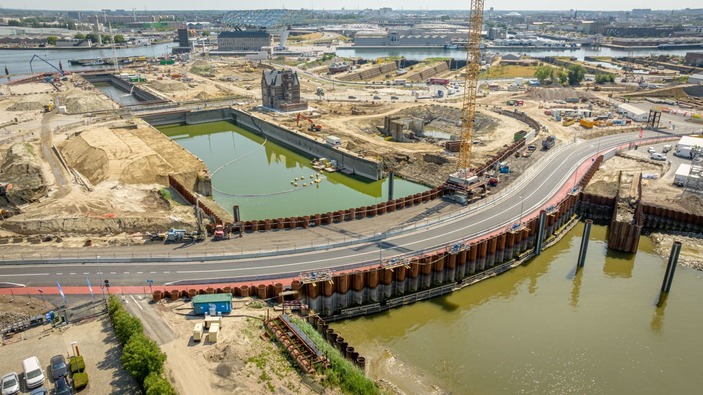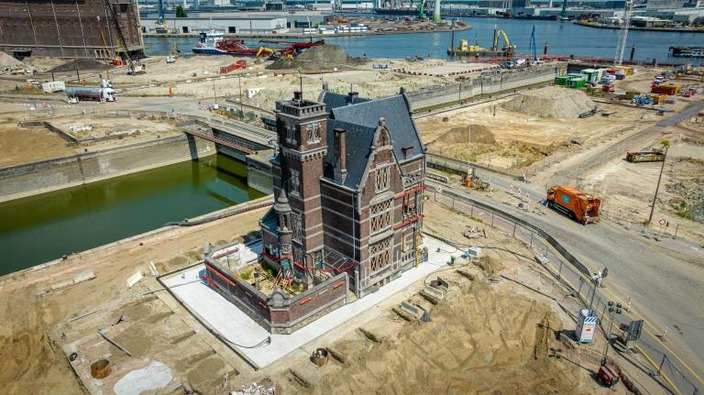Cutting edge technology preserves port heritage

The Royers Lock Cofferdam. Credit: Flanders Department Mobility and Public Works
Over its 115 years of service, Royers Lock in Antwerp has been outgrown as maritime shipping pursued the economies of scale of larger vessels. Now, a giant civil engineering project to complete the ring road around the City of Antwerp will renew Royers Lock as a link to inland waterways for the city’s push barges and inland vessels.
The oldest and most southerly of the five locks between the Scheldt and the Port of Antwerp’s right bank, Royers Lock was first used in 1908. Plans for renewing the ageing lock to address its long lock times, high maintenance costs, and the limitations of its size were accelerated when an impact on the lock chamber wall from a push-convoy permanently closed Royers Lock in February 2021.
At 182.5 metres long, 22 metres wide and 6.30 metres deep, the old lock was only suitable for barges, but was unable to accommodate a convoy of four push barges, creating a bottleneck for inland navigation services, a Port of Antwerp Spokesperson told CEDA Industry News.
An important lock for Antwerp
Despite its limitations, Royers Lock accounted for around 30% of the inland waterway vessels processed on the right bank of Antwerp, according to Inland Navigation Europe. With the lock out of action, vessels are currently rerouted to mixed inland and maritime locks in the area, incurring additional costs and delays as a result of the detour.
“In the absence of the Royers lock, the van Cauwelaert lock is now used as a dedicated barge lock… for ships from the Albert Canal to the Scheldt South of the port, this is a detour. The fact that the capacity of the Royers lock has fallen away, has an effect on the capacity utilization of the other locks. Especially at peak times inland navigation might have to wait a little longer,” said the Port of Antwerp Spokesperson.
The contract to replace Royers Lock was awarded as part of Oosterweel link —a project to complete the Antwerp ring road— by Flemish public body Lantis to the Rinkoniên consortium, a group consisting of Boskalis, Mobilis, CIT Blaton, Artes Group and Stadsbader. The Flemish Government and Port of Antwerp-Bruges are footing most of the €288 million bill for the project, with further contributions from the City of Antwerp and utility company Water-Link.
Construction started in October 2021 and the new lock is due to enter into service in December 2027. The renovated Royers Lock will have a length of 235 meters, a width of 36 metres and a depth of 6.41 metres. The renewed lock will form part of the Scheldt river basin flood defences, increasing the region’s climate resilience.
The Port of Antwerp said it expects a large portion of its inland vessel traffic to use the refreshed lock, and that it will enable the smoother movement of barges through the port.
Complex operations
Renewing the locks will be a multi-stage process that includes the installation of two new lock heads, the renewal of the lock chamber doors, walls and filling system, the construction of a pipe tunnel beneath the lock, two road bridges capable of handling extreme loads, renovation of the lock keeper’s house and construction of machinery buildings and smaller structures, and the renewal and widening of the lock brake works.
The early stages of the project included dredging and earthworks, piling works for the construction of a 20 metre-deep construction pit, and the removal of existing 15 metre concrete foundation piles. In all, 400,000 m³ of soil will need to be removed from the construction pit and 435,000 m³ of soil will be needed to refill the site, with 75% of the soil transportation handled by barge.
Adding to the complexity of the project records dating back to 1700 showed there used to be a river at the site, and the soil beneath the lock has since been repeatedly disturbed by historic engineering activity.
A Site Engineer for the Flanders Department of Mobility and Public Works told CEDA Industry News that the access channel around the lock is continuously dredged by sweeping using Jan de Nul’s oil spill & sweep dredging vessel Pieter Coecke.
To enable the works to be carried out in the dry, a cofferdam has been built to separate construction works from the river Scheldt. A two-week sweep dredging campaign followed by a month of dredging by Boskalis’ hydraulic crane pontoon Medusa brought the area down to the solid base required for the cofferdam, and the dredged material was deposited at either Punt van Melsele or Ketelputten depending on the tide.
The Lock Keeper’s House
Conducting large construction projects in historic areas introduces extra challenges and in the case of Royers Lock, the lock keeper’s house is a protected building. The foundations of the building have been extensively reinforced to ensure it is not damaged during the heavy works. The location of the house in the middle of extensive groundworks makes for striking images - a brick house built in 1907 on a small concrete island surrounded by heavy excavation and groundworks.

Royers Lock Keepers House. Credit: Flanders Department Mobility and Public Works
Surrounding the building with diaphragm walls was a great technical challenge and came at great expense, but the conservation of the neo-Flemish renaissance lock keeper’s house will enable it to serve as the lock control building in the future while maintaining the heritage of the site.
The need to protect the lock keeper’s house was among the reasons the project adopted fully integrated 3D Building Information Modelling (BIM) into its processes. By creating detailed sub-models of the various components of the project – including the lock and its machinery, supporting infrastructure, bridges, and other equipment – a coherent, qualitative design and scope of works was produced.
The models provided detailed information in preparation for carrying out the works, enabling transparent cooperation between parties and identifying possible clash points across assembly and maintenance. Concrete, steel, infrastructure, and earthworks sub-models were available under the BIM system, which won the 2023 Golden Belgian BIM Award at the Belgian Construction Awards.
Work continues
With the cofferdam established, the construction pit could be excavated to its 20 metre depth as groundwater levels were lowered in the area. Demolition of the old lock is currently underway and preparations are being made for concrete works for the new lock.
Works at Royers Lock are closely coordinated with those at the nearby Oosterweelknoop, a project awarded by Lantis to the same Rinkoniên consortium. The Oosterweelknoop will link the Scheldt tunnel with the Channel tunnels which run underneath the Royers Lock site, creating a connection to the Antwerp ring road through a sunken junction. The sites for the projects overlap, with the upper lock head of Royers Lock and tunnel tube linked.
The junction will serve as an entrance and exit to the tunnels and the road network, reducing freight traffic volumes towards Groenendaallaan and Schijnpoort. The building of the tunnels is another major construction project, which will involve sinking pre-constructed tunnel segments into a trench dredged in the Scheldt.
The Oosterweel Junction project involves filling part of the Noordkasteel pond, a process which began with the dredging of 21,000 m³ of sludge from the bottom of the pond. Once dredged, the pond will be closed off with steel sheet piles and filled with 40,000m³ of soil. At least 100,000 tonnes of dredged material and 125,000 tonnes of soil are set to be moved during the works at Noordkasteel pond and offloaded by hopper barges to minimise environmental impact and traffic loads on nearby roads.
Technology enabling collaboration
Dredging is a small but essential component of the mega projects underway at Antwerp, and the contractors and subcontractors involved are few among the dozens of companies and authorities involved in the projects. Due to the employment of a holistic model across the works, the multiple consortium partners, contractors and subcontractors working at Royers Lock from 2021 to 2027 will be able to run in parallel with the Oosterweelknoop project, which runs from 2023 to 2027, with minimal interference.
Construction of the waterborne infrastructure for Royers Lock is expected to be completed by 2026, with the complex in operation by the end of 2027, eliminating the capacity bottleneck at Antwerp. The next campaign of dredging work is expected to begin next year, reconstructing the banks and carrying out guide work in the access channel.
While the advice given in this editorial content has been developed using the best information available, it is intended purely as guidance to be used at the user’s own risk. No responsibility is accepted by CEDA or by the Intent Communications Ltd or by any person, firm, corporation or organisation who or which has been in any way concerned with the furnishing of information or data, the compilation, publication or any translation, supply or sale of this Guidance for the accuracy of any information or advice given herein or for any omission herefrom or from any consequences whatsoever resulting directly or indirectly from compliance with or adoption of guidance contained therein even if caused by a failure to exercise reasonable care.